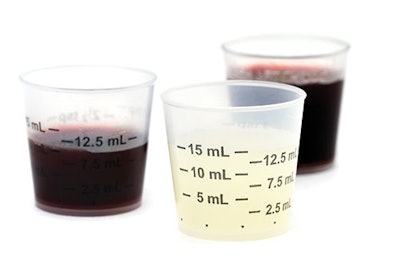CHOOSING WISELY® UPDATE: Strategies to avoid patient harm when prescribing liquid medication
Liquid medications are frequently used in otolaryngology, whether for pediatric patients after common operations such as adenotonsillectomy, or for adult patients recovering from head and neck operations. Unlike other forms of medication, liquid medications are usually measured out each time a dose is administered, creating recurring opportunities for dosing errors.
Karthik Balakrishnan, MD, MPH, and Michael J. Brenner, MD, for the Patient Safety and Quality Improvement (PSQI) Committee

As prescribing providers, we can play a major role in reducing these errors by becoming more aware of these risks and by employing simple prevention strategies. Here’s what you can do to reduce this problem and reduce your patients’ risk from liquid medications.
Many clinicians are familiar with the Choosing Wisely campaign, which aims to use simple, evidence-based tips to improve the quality and safety of care while reducing costs. The Institute of Safe Medication Practices and the American Society of Health-System Pharmacists have produced a list of Choosing Wisely recommendations that includes the following:
“Do not prescribe or administer oral liquid medications using teaspoon or tablespoon for measurement; use only milliliters (mL) when measuring with an approved dosing device (e.g., medication cup or oral syringe).”
Dr. Shannon Manzi, director of the Clinical Pharmacogenomics Service and Pharmacy Manager for ICU and Emergency Services at Boston Children’s Hospital and Harvard Medical School, said that parents and caregivers frequently mistake measuring spoons of different sizes (tablespoon and teaspoon). She also observed that non-English-speaking individuals and those with lower health literacy might be especially vulnerable to such errors. “Clearly, a three-fold overdose of certain medications could result in harm.”
Chad Brummett, MD, director of Clinical Research in the Department of Anesthesiology at the University of Michigan, noted that when it comes to opioid medications in particular, “the results of such mistakes can be devastating, including respiratory arrest and death.”
With over 500,000 children undergoing tonsillectomy in the United States each year (Boss EF J Pediatrics 2012) and many more patients requiring liquid medications for other reasons, otolaryngologists have the opportunity to make a difference in this problem.
1. Use only metric units (milliliters or milligrams) when prescribing. If prescribing in milligrams, make sure that the correct medication concentration (milligrams per milliliter) is prescribed.
Many practices and institutions have already made this change, particularly with the advent of computerized prescribing and order entry. Kevin Graner, R.Ph., senior manager of Pharmacy at the Mayo Clinic, noted that for inpatient prescribing at Mayo, all medications are ordered in milligrams. The ordering system then automatically converts dosages to milliliters for pharmacists and nurses to dispense and administer doses. On the outpatient side, electronic ordering records the liquid medication concentration and forces prescribing in milliliters so that caregivers and patients do not have to do dose calculations themselves. Boston Children’s Hospital takes the same approach, said Dr. Manzi. Both institutions have essentially eliminated free text prescribing to further reduce risk.
For practices using paper or free text prescribing, extra attention may be warranted. Some options to reduce risk might include preprinted prescriptions to improve legibility; double-checking prescriptions to confirm correct dose, concentration, and units; and standardization of prescription format, language, and units.
2. Use oral syringes with metric (milliliter) dose markings to administer all liquid medications.
A recent randomized controlled trial demonstrated that 84 percent of parents make at least one dosing error when providing their child medication, and 21 percent gave double the prescribed dose or more at least once. “The odds of dosing errors were 4.6 times higher when medication cups were used compared to oral syringes.” This finding held true across different patient language and health literacy groups. No difference was seen between syringes with 0.2 mL and 0.5 mL markings. However, the use of teaspoon markings increased the rate of errors compared to milliliter markings (Yin HS et al Pediatrics 2016).
Mr. Graner noted that Mayo Clinic has converted to oral syringes with only milliliter markings and that many syringe manufacturers are making the same shift. Dr. Manzi suggests one future intervention could be to require retail pharmacies to provide oral syringes with metric units for all liquid prescriptions and labeling over-the-counter liquid medications with dose strength (milligrams) and corresponding milliliter dose volumes. A current option is to educate patients at the time of prescription that only oral syringes should be used.
3. Consider opioid prescriptions with particular care.
While the epidemic of opioid addiction has received a great deal of news attention recently, Dr. Brummett has demonstrated that persistent opioid use and dependence (lasting greater than 90 days) begins after even minor medical procedures in over five percent of adult patients, compared to four-tenths percent of nonoperated control patients. Patients at higher risk included those with mood disorders, tobacco, alcohol, or other substance abuse history, anxiety, and preoperative pain disorders.
“Chronic opioid use is independently associated with morbidity and mortality and should be considered by patients and providers when assessing postoperative risk and clinical care,” he said.
We hope that our fellow otolaryngologists will consider these issues and preventive steps when prescribing liquid medications and opioids. Our specialty has an important role to play in keeping our patients safe from these harms.











